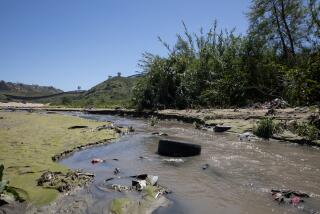Bacteria Level Near Sewage Spill Drops
SAN DIEGO â County health authorities reported that bacterial counts dropped for a second day Friday but, despite the news, said they will continue to quarantine 20 miles of coastline through the weekend.
For the fourth straight day, only the tip of the Point Loma Peninsula recorded readings of fecal coliform bacteria in excess of the legal limit, and once again, health officials blamed concern over the daily overflow of 180 million gallons of partially treated sewage offshore for the closures.
âWeâre trying to get a better handle on what the currents are doing and what the plume of sewage is doing, and so far--barring a storm--it continues to move in a southerly direction,â said Dan Avera, a spokesman for the San Diego Department of Health Services.
The spill, which the Coast Guard discovered Feb. 2, continues to spew 170 million to 180 million gallons a day of treated sewage--from which 75% to 80% of the solids have been removed--3,150 feet from the cliffs of Point Loma, at a depth of 35 feet.
Ordinarily, the sewage is discharged 2.2 miles at sea, at a depth of 220 feet, but the huge outfall pipe that carries it is ruptured in 22 sections three-quarters of a mile from shore. This week, divers discovered more damage near the one-mile mark, about 55 feet deep.
In other developments, the city announced that two groups of scientists from Scripps Institution of Oceanography will assist in assessing the biological effects of the spill on the areaâs kelp forests.
The scientists will examine how excessive sedimentation and reductions in sunlight in deeper waters of the kelp beds may have restricted growth.
Mia Tegner, a marine biologist at Scripps, said in a statement issued Friday that the kelp beds âshelter a rich community of marine plants and animals and are an important resource for sport and commercial fisheries and the kelp-harvesting industry.â
More to Read
Sign up for Essential California
The most important California stories and recommendations in your inbox every morning.
You may occasionally receive promotional content from the Los Angeles Times.










